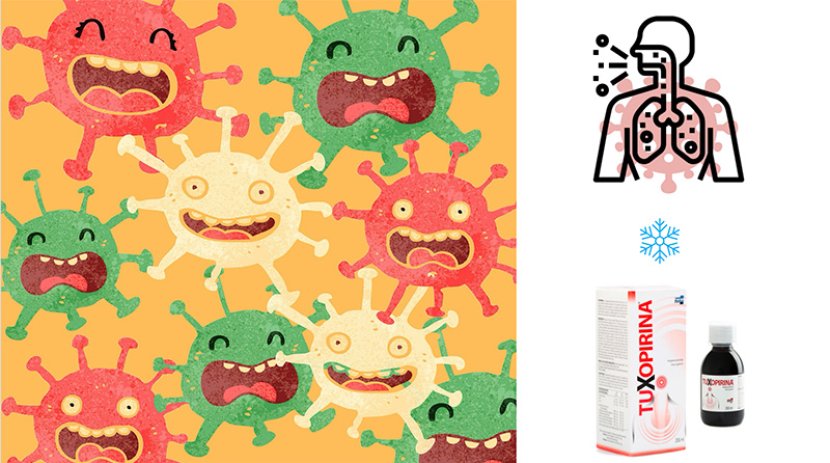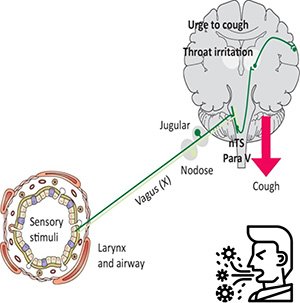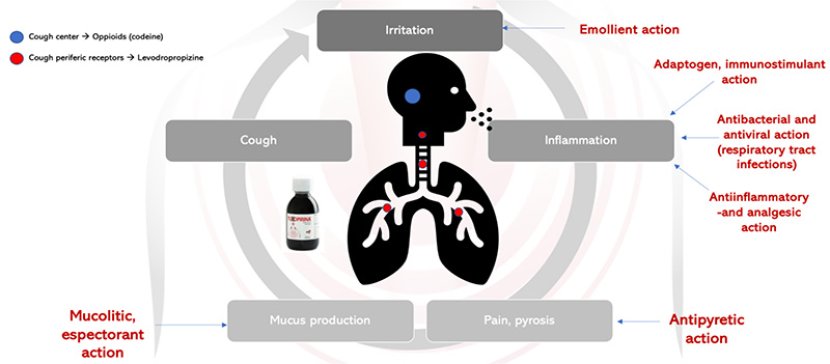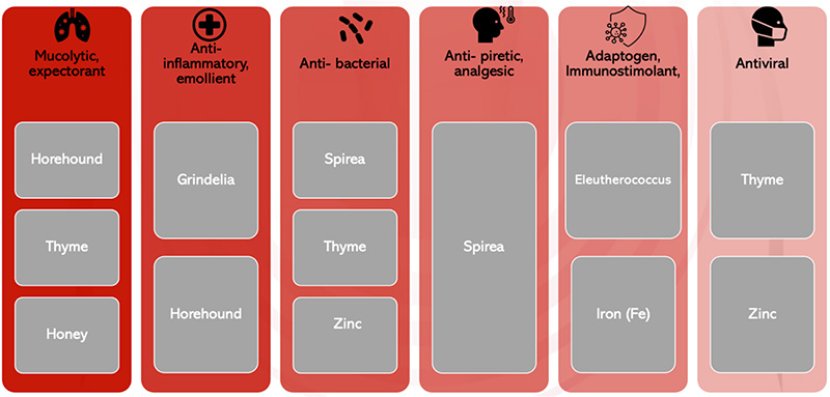Lunedì 04 Dicembre 2023 09:00 / Scritto da Redazione / Categoria Newsletter
CAUSES AND MECHANISM OF COUGH, SYMPTOMS AND TREATMENT
In winter, the drastic temperature changes are a reason for the appearance of flu-like symptoms. There is an increase in susceptibility to infections during the winter months.

Winter cough
In winter, the drastic temperature changes are a reason for the appearance of flu-like symptoms. There is an increase in susceptibility to infections during the winter months. Winter also makes your immune defenses slightly sluggish. With the cooling of the nasal passages, mucus clearance slows down. Additionally, cold air can cause breathing passages to tighten.
These changes can increase cough resulting from infections contracted during winter months. Above all, you must be wary of viruses, which can survive more efficiently during the winter months, increasing the infection rate. Hence, the most frequently infecting microbes during the winter season are viruses. Chronic cough on its own irritates the larynx and can also result in inflammation, which feeds into a loop of cough that results in more cough.
A cough is a spontaneous reflex. When things such as mucus, germs, viruses or dust irritate your throat and airways, your body automatically responds by coughing, thanks to receptors inside the lungs and throat and a complex mechanism of contractions/release of muscles of diaphragm and epiglottis. Similar to other reflexes such as sneezing or blinking, coughing helps protect your body.
- Coughing is an important reflex that helps protect your airway and lungs against irritants.
- Occasional coughing is normal as it helps clear your throat and airway of germs, mucus and dust.
An occasional cough is a normal healthy function of your body. Your throat and airways are equipped with nerves that sense irritants and seek to dispel them. This response is almost instantaneous and very effective.
Throats and lungs normally produce a small amount of mucus to keep the airway moist and to have a thin covering layer that works as a protective barrier against irritants and germs you may breathe in. Some infrequent coughing helps mobilize mucus and has no damaging effects on your body. Coughing also allows for the rapid removal of any unwelcome particles you accidentally breathe in.
There are many different types of coughs with distinct characteristics that can help your doctor identify what underlying issue may be causing it. If a cough brings up phlegm or mucus it is called a productive/wet cough and could suggest pneumonia, bronchitis or the flu. The color of the mucus can signal a more serious problem. You should see a doctor if your cough brings up yellowish-green phlegm or blood. A cough that doesn’t produce mucus is called a dry or nonproductive cough.
Acute cough is the least serious type of cough. It only lasts for three weeks or less and will most likely clear up on its own. This type of cough will not need medical attention. However, if the cough is accompanied by other symptoms such as fever, headache, drowsiness or shortness of breath it should be brought to a doctor’s attention. Coughs that make certain sounds, like whooping, wheezing or barking, may also signal a bigger problem. Chronic coughs last longer than eight weeks and can be the sign of a more serious or chronic lung disease.
Caugh causes
A cough is one of the most common medical complaints accounting for as many as 30 million clinical visits per year. Up to 40% of these complaints result in referral to a pulmonologist. A cough is an innate primitive reflex and acts as part of the body’s immune system to protect against foreign materials.
Cough occurs when the airways are irritated. Likely causes of cough depend on whether the cough has lasted less than 8 weeks (acute) or 8 weeks or longer (chronic).
These are common causes of acute cough – lasting less than two months, especially during cold seasons:
- Upper respiratory tract infections: Infections of the nose and throat are the most common cause of coughing related to illness. They are usually associated with fevers, sore throat and runny nose. They are almost always caused by viruses, and include the common cold, viral laryngitis and influenza.
- Inhalation of irritants: Acute exposure to some fumes and vapors can cause inflammation of the throat and airway and cause cough.
- Lower respiratory tract infections: These are more serious viral and bacterial infections that usually cause a deep, lingering cough and fever. They can affect the airways (bronchitis) or go further into the lungs (pneumonia).

The mechanism of cough
 Coughing is a largely uncontrolled, protective reflex mechanism responsible for mucociliary clearance of the airway and excess secretions within the airway. This reflex is characterized by the closing of the glottis apparatus with subsequent increases in the intrathoracic pressure, which often exceeds 300 mm Hg. This is followed by the forceful expulsion of the airway contents through the glottis into the pharyngeal space and out of the body. Given the forceful nature of this process, mucous secretions are loosened from the wall of the airway and expelled.
Coughing is a largely uncontrolled, protective reflex mechanism responsible for mucociliary clearance of the airway and excess secretions within the airway. This reflex is characterized by the closing of the glottis apparatus with subsequent increases in the intrathoracic pressure, which often exceeds 300 mm Hg. This is followed by the forceful expulsion of the airway contents through the glottis into the pharyngeal space and out of the body. Given the forceful nature of this process, mucous secretions are loosened from the wall of the airway and expelled.
Cough may be a voluntary act or a spontaneous reflex arc and in this case involves receptors, an afferent pathway, a center processing information, an efferent pathway and effectors. The receptors (sensitive and mechanical) are placed throughout the bronchial tree and, although in a lesser extent, also in other areas: ear, paranasal sinuses, pleura, diaphragm, pericardium and esophagus. Airway inflammation (es. Infection), mucus and inhaled irritant substances stimulate receptors. From receptors the afferent impulses are channeled through the vagus nerve in the medulla oblongata, where they are processed in the cough centre. Then, efferent impulses are conveyed by motor nerves and reach the effectors, which are the respiratory and laryngeal muscles.
The mechanism of action for coughing can be subdivided into three overarching phases: the inspiration phase, the compression phase, and the expiratory phase.
- During the inspiration phase, inhalation occurs, generating an increase in volume within the pulmonary system. This volume is necessary for generating enough air movement to be productive.
- The compression phase is marked by the closure of the larynx combined with the contraction of muscles of exhalation, including the intercostals, diaphragm, and abdominals leading to a net increase in intrathoracic pressure without any air movement occurring.
- The expiration phase is marked by the rapid opening of the glottis resulting in rapid, high-volume expiratory airflow. This rapid airflow causes vibrations within the larynx and pharynx, inducing the characteristic sounds of a cough. Throughout this process, airway compression occurs, resulting in a net decrease in intrathoracic volume. After exhalation, rebound inhalation may occur, depending on the duration of a coughing episode as well as the volume of airflow movement, in compensation for developed hypoxia or reflexive inhalation.

Treatment
Although treatment with cough suppressants (antitussives) is often emphasized, we must remember that cough itself is an important defence mechanism by which airway secretion is increased to improve elimination of irritant substances. The cough reflex is essential as a physiological defence mechanism. Therefore, treatment of respiratory diseases with cough must be aimed at enhancing this defence mechanism, rather than mere symptomatic treatment of cough.
Most cases of acute cough should be treated empirically and focus on symptomatic relief. This includes supportive measures of over-the-counter cough and cold medicines. However, many over-the-counter antihistamine-decongestant medications have been shown to offer no clinical benefit over placebo. Cough suppressants may be used to lessen the cough by blunting the cough reflex, and expectorants may be used when excessive mucous secretions are determined to be the primary issue to increase mucus clearance. The most commonly used suppressant is dextromethorphan, and the most common expectorant is guaifenesin. It is important to remember, however, that coughing is a basic defense mechanism and plays an important part in the body’s immune system. Therefore, decreasing the cough reflex may have detrimental impacts on the recovery time of illness. As such, the current American College of Chest Physicians guidelines does not recommend the use of peripherally or centrally-acting cough suppressants for the treatment of cough due to and discourage the use of over-the-counter combinations for the treatment of acute cough due to the common cold. Also some of these drugs could lead to adverse side effects:
- Cough suppressants: All opioids suppress cough because they reduce the responsiveness of the cough center in the brain. Codeine is the opioid used most often for cough. Codeine and other opioid cough suppressants may cause nausea, vomiting, and constipation and may be addictive. They can also cause drowsiness, particularly when a person is taking other drugs that reduce concentration (such as alcohol, sedatives, sleep aids, antidepressants, or certain antihistamines). Dextromethorphan is related to codeine but is technically not an opioid. It also suppresses the cough center in the brain. Dextromethorphan is the active ingredient in many over-the-counter (OTC) and prescription cough preparations. It is not addictive and, when used correctly, causes little drowsiness. However, it is frequently abused by people, particularly adolescents, because in high doses, it causes euphoria. Overdose causes hallucinations, agitation, and sometimes coma.
- Some doctors recommend expectorants (sometimes called mucolytics) to help loosen mucus by making bronchial secretions thinner and easier to cough up. Expectorants do not suppress a cough, and evidence indicating effectiveness of these medications is lacking. The most commonly used expectorants are over-the-counter preparations that contain guaifenesin. Also, inhaling a saline (salt) solution or inhaling acetylcysteine (for up to a few days) sometimes helps thin excessively thick and troublesome mucus.
Very useful are cough syrups, as food supplements, containing herbal extracts and micronutrients. Compared to drugs, they don’t have side effects and the synergic action of the components could help to solve the condition in a more complete way. Instead of acting directly on the suppression of the cough center, these syrups contrasts both the symptoms and causes, reducing the irritation of the throat, stimulating the immune defences, acting as mucolytic and expectorant and neutralizing the cough vicious cycle of irritation -> cough -> irritation.

Tuxopirina

Tuxopirina® is a dietary supplement (syrup) of Vitamin B6, Iron and Zinc with White Horehound, Grindelia, Thyme, Spirea and Eleutherococcus.
Tuxopirina® is an adjuvant in the treatment of respiratory tract diseases, thank to a completly natural complex of synergic active ingredients with an antitussive-anti- inflammatory-mucolytic-antipyretic-immunostimulant action . Tuxopirina® ensures a complete treatment on cough, acting both on different symptoms & causes and helping the resolution of the condition.
Indicated, in both adults and children (>12 years):
- Sore throat
- Bronchitis
- Laryngitis
- Tracheitis
- Dry or Wet cough
- Excess of mucus
- Flu, Cold and other viral/bacterial infections of the upper respiratory tract (stagional diseases)
It has a pleasant taste of bilberry juice.
- HOREHOUND Marrubium vulgare (Leaves and aerial parts hydroglyceric extract). It has bronchhial expectorant and mucolythic properties useful in the catarrhal congestions, bronchitis and astma thanks to its diterpenic and organic acids fraction. It fluidifies and disinfect mucosal secretions, facilitanting its elemination
- GUMPLANT Grindelia robusta (top and leaves fluid extract). Grindelia has a balsamic and emollient/lenitive activity useful for the right functionality of the oro-pharynx mucosa. It has also anti-inflammatory/bacterial activity on the mucosa of the respiratory tract; it normalizes the stimulation of the breathing centre and suppress the coughing one, thanks to the resinous terpenic fraction of the essential oil. Useful in the treatment of asthma, bronchitis, laringitis, anti-tussive.
- THYME Thymus serpyllum (flowers and leaves hydroglyceric extract). The active ingredients in the essential oil have antiseptic, balsamic, antispasmodic, bronchial mucolytic (timol has antibiotic action on Staphylococcus), expectorant activity of respiratory tract diseases.
- MEADOWSWEET-SPIREA Filipendula ulmaria (flowers hydroglyceric extract). It is indicated in the treatment of cold diseases due to its antiinflammatory, analgesic and antipyretic activities (presence of salicylic acids, precursor of acetilsalicylic acid).
- ELEUTEROCOCCUS Eleuterococcus senticosus (root hydroglyceric extract.). Adaptogen and immunostimualting activity thanks to eleuterosides. It is used in asthenia and stress conditions and during convalescence as tonic. Numerous studies its efficency and preventive action against flu syndrome and other respiratory diseases.
- HONEY: rich of fructose, glucose, vitamins and trace elements
- VITAMIN B6. Implied in numerous metabolic reactions of amminoacids and sythesis of NT. The deficit of Vitamin B6 reflects on the central nervous system, on the mucosa and on the skin. Its deficit may be the con-cause of anemiae and it is certainly, an useful adjuvant in the treatment of inflammatory diseases of oral cavity when associated with zinc and iron.
- IRON (Gluconate). The main indications for the use of iron as an adjuvant in the treatment of anemiae, infections and learning fatigue.
- ZINC (Gluconate). Co-factor of more than 200 metal enzymes. One very important characteristic of zinc is to stabi- lize the cellular membranes and the nucleic acids. It has an antiviral and antibacterial activity and increases the immunitary response and the removal of free radicals: Its deficit produces a generalized malfunctioning of all the body systems mainly the immunitary, endocrine and reproductive one.


In red: approved botanicals claims for food supplments in Italy (Directoral Decree prot. 33391 1 August 2022, Annex 1
Echitus

Echituss is a food supplement (Syrup) of Vitamin B6, Iron, Zinc, with Propolis and extracts of Altea, Horehound, Echinacea and Thyme. Echitus acts as an adjuvant in the treatment of airway diseases with stimulating activity on the immune defenses. It is suitable for pediatric use.
Echitus represents the most complete adjuvant for the treatment and the prevention of respiratory diseases:
- Symptomatic action
Althea officinalis polysaccharide complex: emollient and expectorant activity
Thymol: Bechic and antispasmotic Marrubina: Fluidifier and antiseptic
Iron and Vit B6: Adaptogens and anti-stress
- Anti-infective action and immunomodulatory activity
Echinacoside: immunomodulating and stimulating the production of T lymphocytes.
Propolis: antibacterial, antiviral and anti-inflammatory activity
Zinc: immunostimulating and antiviral
The natural formulation of ECHITUS and the dosages of components can allow, subject to the pediatrician's judgment, the use of the product even in early childhood. (>3 years)
ECHITUS is a useful adjuvant for the recovery of the normal physiological conditions of the respiratory tract and can have an immunomodulatory action in colds.
It has a pleasant taste of bilberry juice
ALTHEA OFFICINALIS POLYSACCHARIDE COMPLEX. Always used as an emollient in laryngo-tracheal affections, its extractive complex is rich in mucilages (25%), flavonoids and a polysaccharide whose activity on the mucous membranes of the upper respiratory tract has been tested.
THYMOL from Thymus vulgaris. An essential oil rich in phenols, flavonoids, triterpenic acids, saponins with antibiotic activity is extracted. Thymol and carvacrol have proved to be among the most important phenols and have been identified as responsible for the antispasmodic, expectorant, mucolytic and antiseptic activity of thyme.
HOREHOUND. The extractive complex of Marrubium vulgare has multiple properties on various organs and systems. It has a demonstrated mucolytic and expectorant activity, due to diterpenic substances, mucilages and pectins. Recently > an ester of a derivative of AC has been isolated in the extract of M. caffeic having an inhibitory action on the cyclo-oxygenase catalyzing the synthesis of prostaglandins, and studies are therefore underway on its potential anti-inflammatory activity.
ECHINACOSIDE. | The active ingredients of Echinacea purpurea are various and with diversified actions such as anti-infective agents, echinacoside phytocomplex, terpenic essential oils, heteroxylan polysaccharides and arabinoramnogalactans, etc. The echinacoside phytocomplex has bacteriostatic and virustatic properties tested on numerous bacterial and viral strains. In particular it has the property of inhibiting the bacterial enzyme hyaluronidase and therefore of delaying the attack of the microorganisms on the target cells. Heteroxylans and arabinoramnogalactans, on the other hand, have a well-documented stimulating activity on various immune cell lines: they increase the production of lymphocytes 7, increase the diffusion and levels of neutrophils, stimulate leukocyte phagocytosis, increase the activity of the killer cells of the immune system. Echinacea is useful for the functionality of the upper respiratory tract.
PROPOLIS. It contains many complex substances, organic acids, mineral salts and trace elements. The essential oil has demonstrated significant antibacterial activity against gram positive and negative bacteria. Among the flavonoids, galengin and pinocembrin have shown intense antibacterial activity on gram positives. Again on gram positives, cinnamic acid proved to be very active among the organic acids, in particular on staphylococci and streptococci, which are always present in the respiratory tract. However, a remarkable bacteriostatic activity has also been demonstrated in vitro on various gram negatives (salmonella ssp, escherichia coli, proteus vulgaris, shigella, etc.). It has also been seen that the antimicrobial activity of propolis is expressed at various levels with a lysis and a disorganizing action on the wall and on the cytoplasm, but also by an inhibition of the DNA-dependent ma-polymerase which leads to the failure of daughter cells to separate.
ZINC (Gluconate). Its very important role as a constituent of many enzymatic systems has been amply demonstrated. In particular, Zinc is essential for the production of T lymphocytes, its deficiency also leads to atrophy of the thymus and lymphoid tissues and to a lower production of immunoglobulins. Numerous studies highlight the role of Zinc in the prevention of respiratory infections, as it increases the efficiency of the immune system, while other clinical studies show that the intake of Zinc leads to a net reduction in the duration and symptoms of airway diseases. Among other things, its interference on viral reproduction has been highlighted, especially of the genus rhinovirus.
IRON (Gluconate) and VITAMIN B6. Both universally recognized as adaptogens and anti-stress. In particular, pyridoxine also enters enzymatic systems that lead to the formation of neuroamines.

In red: approved botanicals claims for food supplments in Italy (Directoral Decree prot. 33391 1 August 2022, Annex 1)
---
https://coughpro.com/blog/understanding-seasonal-cough/
https://www.lung.org/lung-health-diseases/warning-signs-of-lung-disease/cough/learn-about- cough#:~:text=Cough%20Causes&text=Upper%20respiratory%20tract%20infections%3A%20Infection s,cold%2C%20viral%20laryngitis%20and%20influenza.
https://www.msdmanuals.com/home/lung-and-airway-disorders/symptoms-of-lung-disorders/cough-in- adults
https://onlinelibrary.wiley.com/doi/pdf/10.1111/j.1440-1843.2006.00920_2.x https://www.ncbi.nlm.nih.gov/books/NBK493221/
Imran Satia, Huda Badri, Bashar Al-Sheklly, Jaclyn Ann Smith, Ashley A Woodcock Clinical Medicine Dec 2016, 16 (Suppl 6) s92-s97; DOI: 10.7861/clinmedicine.16-6-s92
Nosal’ova, Strapkova A, Kardosova A ecc.:Antitussive action of extracts and polysaccarides of marsh mallow (Althea officinalis L). Pharmazie. 1992. Mar, 47(3):224-6.
Mongraph EU 1984 Nr.228 F.U IX
Sahpaz S, Garbacki N, Tits M, Bailleul F: Isolation and pharmacological activity of phenylpropanoid esters from Mamubium vulgare, Etnopharmacol.2002 Mars; 79(3):389-92. O
Stephen Foster:Echinacea, Nature's Immune Enhancer. Healing Arts Press, 1991
Christopher Hobbs: Echinacea the immune Herb, Botanica Press, 1990,
Steinmulleret al.IntJlmmunopharmac, Vol.15, No.5, pp.605-614, 1993. n i o
Brauning B,.Dom M. et al: Echinacea purpurea root for Stregthening the immune Response in Flu-like Infections. Zeitschrift Phytother 13:7-13,1992.
Murray M.ND; Pizzomo J,ND. Foocopea of Natural Medicine,second ed.Prima Publishing, Rocklin, 1999, Pizzomo J,ND: Murray M. T., Eds Textbook of Natural Medicine, second ed. Churchill Livingstone, 1999.
Dom M.,É.Knick, G.Lewith.1997. Placeb-controlled,double-blind study of Echinacea pallidae radix in upper respiratory tract ijnfections, Complement Ther Med 5;40-42,
Lindemuth G.F. and EB. Lindenmuth (Rue The Gig) of Echinacea compound herbal tea preparation on the severity and uao of upper respireatory and flu syntoms: a randomized, double-blind placebo-controlled study.J. Complement 6(4): 327-34.
Andrani F, Aiello M, Bertorelli G, Crisafulli E, Chetta A. Cough, a vital reflex. mechanisms, determinants and
measurements. Acta Biomed. 2019 Jan 15;89(4):477-480. doi: 10.23750/abm.v89i4.6182. PMID:
30657115; PMCID: PMC6502102.
Umayahara, Y.; Soh, Z.; Sekikawa, K.; Kawae, T.; Otsuka, A.; Tsuji, T. Clinical Significance of Cough Peak
Flow and Its Non-Contact Measurement via Cough Sounds: A Narrative Review. Appl. Sci. 2020, 10,
2782. https://doi.org/10.3390/app10082782
Ansorge s., Reinhold D., Lendeckel U.:Propolis and some of its constituents down-regulate DNA synthesis and inflammatory cytokine production but induce TGF-betal production of human immune cells.Z. Naturforsch(C). 2003 Lug-Aug;(7-8):580-9.
Abd El Hady FK, Hegazi AG:: Egyptian propolis: Chemical composition, antiviral and antimicrobical activities of East Nile Delta propolils.Z.Naturforsch(C). 2002 Mar-Apr 57 (3-4) 386-94
Rossi A, Longo R, Russo A. Borelli F,Sautebin L: The role of phenethy! ester of caffeic acid in the inibition of rat lung cyclooxygenase activity by Ponto ia, 2002 Nov; 73 Suppl 1:530-7.
Duarte 5, Koo H, Bowen WH;, Hayacibara MF, Cury GA:, Ikegaki M,, Rosalen PL: Effect of a novel type of propolis and fractions on glucosyttranferases and on growth and adhenence of mutans streptococci. Biol. Pharm. Bull. 2003 1;264(4).527-31.
Kartal M,, yildiz S., Kaya S., Kurucu S., Pa G.: Antimicronial activity of propolis samples from two different regions of Anatolia. J. EthnopharmacoL 2003, May; 86(1): 69-73
Sa-Nunes A, Faccioli LH:, Sforcin JM: Propolis: |mphocyte profiferation and IFN-gamma production, J.Etnopharmacol. 2003 Jul:87(1}:93-7.
Stach K, Stach W, Augoff K. Vitamin B6 in Health and Disease. Nutrients. 2021 Sep 17;13(9):3229. doi: 10.3390/nu13093229. PMID: 34579110; PMCID: PMC8467949.
Pieracci FM, Barie PS. Iron and the risk of infection. Surg Infect (Larchmt). 2005;6 Suppl 1:S41-6. doi: 10.1089/sur.2005.6.s1-41. PMID: 19284357.
Shankar AH, Prasad AS. Zinc and immune function: the biological basis of altered resistance to infection. Am J Clin Nutr. 1998 Aug;68(2 Suppl):447S-463S. doi: 10.1093/ajcn/68.2.447S. PMID: 9701160.
Read SA, Obeid S, Ahlenstiel C, Ahlenstiel G. The Role of Zinc in Antiviral Immunity. Adv Nutr. 2019 Jul 1;10(4):696-710. doi: 10.1093/advances/nmz013. PMID: 31305906; PMCID: PMC6628855.
Costantini AM. et al.: Fondamenti di nutrizione umana.ll Pensiero Scientifico Editore, 389- 399,1999.
Società Italiana di Nutrizione Umana:Livelli di assunzione raccomandati di energia e nutrienti per la popolazione italiana. LARN. Revisione 1996,140-145,
Costantini AM. et al.: Fondamenti di nutrizione umana.ll Pensiero Scientifico Editore, 389- 399,1999.
Shackelford RE:, Manuszak RP. Johnson CD, et al. Desferioxamine treatement increases the genomic stability of Ataxiatelangiectasia cells. DNA Repair (Amst).2003 sep 18,2(9):971-81.
Fidanza A: Le vitamine .Ed. Agnesotti. Roma, 1990.


